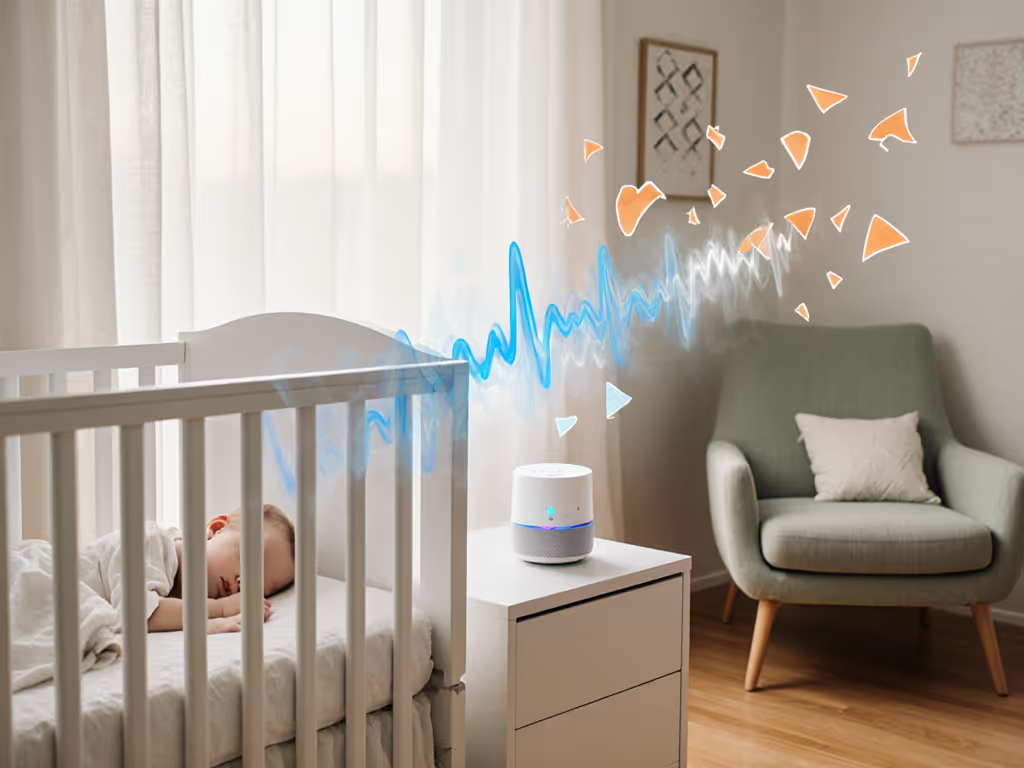
White Noise's Cognitive Impact on Infant Brain Development
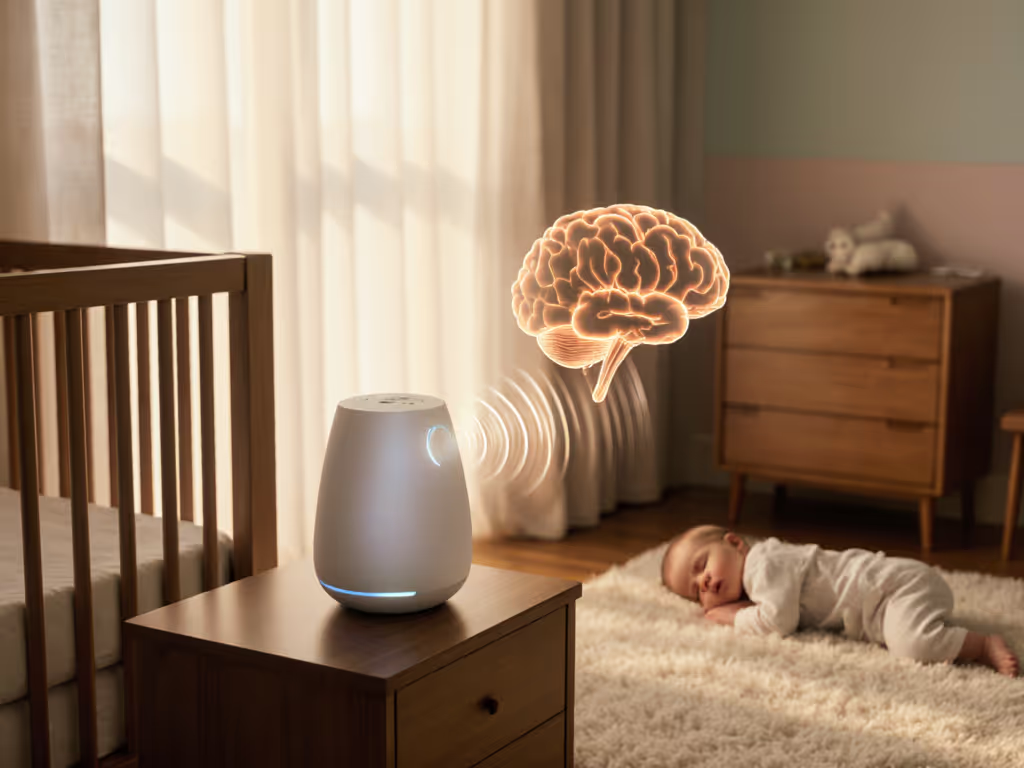
We've all been there, 3 a.m. in a cramped apartment, desperate for just one more hour of sleep while your baby seems equally exhausted yet unable to settle. The search for a quiet environment quickly leads many parents to white noise machines, but what is often overlooked is how these soundscapes shape infant brain development. Recent research reveals profound cognitive effects white noise can have on developing neural pathways, effects that extend far beyond whether a baby falls asleep faster. For foundational context, see our infant sleep science explainer on white noise and brain development. As someone who maps error-prone interfaces in low-light conditions, I've witnessed how seemingly innocuous design choices echo in the dark more than you think.
FAQ Deep Dive: Understanding White Noise's Impact on Your Baby's Brain
How does white noise actually affect infant brain development?
Research shows continuous white noise exposure during sleep creates what neuroscientists call "auditory masking" (a state where the brain stops processing nuanced sound variations critical for language acquisition). A landmark UCSF study published in Science demonstrated that constant white noise sabotages the development of the auditory region in the brain, potentially impairing hearing and language skills. This happens because infant brains rely on subtle sound distinctions (mere milliseconds apart) to build "acoustic maps" (neural networks that help differentiate phonemes like "p" and "b" in words). These networks primarily form during the first year of life, when babies spend 16-20 hours daily asleep yet actively processing environmental sounds. For stage-by-stage recommendations that align with developmental windows, consult our age-based usage guide.
What specific cognitive effects does white noise have on developing brains?
Studies reveal that while white noise may help babies fall asleep initially, the cognitive effects it creates can be concerning:
- Language development delays: By blocking the subtle sound variations infants need to distinguish phonemes, white noise machines interfere with the neural development those machines claim to support.
- Reduced auditory discrimination: Infants exposed to continuous white noise show diminished ability to differentiate between similar speech sounds, a critical skill for language acquisition.
- Altered neural plasticity: Research in Nature Scientific Reports (2023) confirmed that both 4- and 9-month-old infants' brains are highly sensitive to sound duration, with white noise potentially disrupting this natural processing.
- Overstimulation risks: Many machines emit high-frequency "hiss" that exceeds safe decibel levels at crib distance, with some reaching 85+ dB, which exceeds safety guidelines for adults in industrial settings.
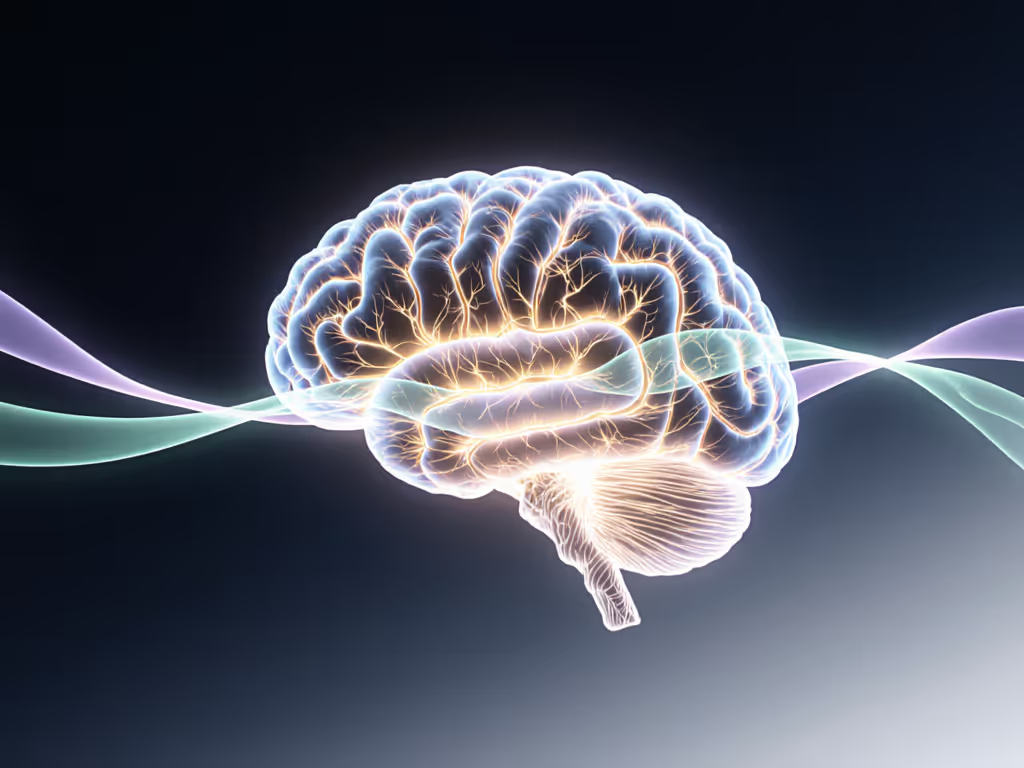
Can white noise machines cause permanent damage to my baby's hearing?
Current evidence suggests white noise machines probably do both: studies show babies can fall asleep faster and that some machines exceed safe decibel levels. A 2014 Pediatrics study tested 14 white noise machines and found all exceeded 45 dB (the recommended maximum in hospital nurseries), with three exceeding 85 dB, levels considered unsafe for prolonged adult exposure. While temporary threshold shifts (temporary hearing loss) are possible with excessive volume, the greater concern lies in how continuous exposure affects auditory processing during infant development. The brain adapts to constant sound, potentially creating "auditory processing disorders" where children struggle to filter relevant sounds from background noise, a critical skill for classroom learning.
What are the long-term white noise effects we should be concerned about?
The research on long-term white noise effects remains evolving, but concerning patterns emerge:
- Language acquisition challenges: Children exposed to heavy white noise during critical development periods show modest delays in language milestones.
- Attention difficulties: Some studies suggest possible links between excessive white noise exposure and later attention challenges, as the brain adapts to constant stimulation.
- Sleep dependency issues: Babies may develop reliance on white noise to fall asleep, creating challenges when traveling or moving to different environments.
A 2024 meta-analysis in Noise & Health found that while short-term benefits exist, evidence suggests deleterious effects of continuous moderate-intensity white noise exposure on early development, particularly when used at high volumes for extended periods.
How can we support healthy baby brain growth without compromising sleep?
This is where thoughtful design prevents noise before it starts. Rather than relying solely on white noise, consider these evidence-based approaches:
- Diversify soundscapes: Rotate between classical music, lullabies, nature sounds, and womb sounds to provide varied auditory stimulation that supports neural development that many machines lack.
- Volume precision matters: Aim for 45-50 dB at crib level (about the sound of a soft shower). Test with a calibrated decibel meter app while standing where baby's head would rest.
- Strategic placement: Position devices across the room from the crib, not directly beside it, so white noise remains a background presence rather than a foreground element.
- Time-limited exposure: Use white noise only during sleep transitions, not all night, to allow periods of natural sound processing.
When my studio apartment's glossy touch panel started waking our baby with its faint chirps, we replaced it with a compact unit featuring a physical dial and no glow. That night taught me that ergonomics are sleep tools too, place it right, sleep stays tight.
What should parents look for in sound machines from a design perspective?
As a low-light ergonomics specialist, I evaluate these critical features:
- Tactile controls: Physical dials with precise volume increments (not touch-sensitive panels that activate accidentally)
- Complete light elimination: No LED indicators that create lumen spill in dark rooms
- Frequency profile: Machines with balanced sound spectra that avoid harsh high-frequency "hiss"
- Consistent output: No audible loops, clicks, or volume jumps between tracks
- Cable management: Shorter cords that prevent tripping hazards in small spaces
- Reliability: Auto-restart after power interruptions without losing settings
Are there alternatives to traditional white noise machines?
Absolutely. Consider these approaches that support baby brain growth without the risks:
- Natural soundscaping: Strategically placed fans (positioned away from direct airflow on baby) provide gentle, variable white noise without artificial tones.
- Sound-conditioned environments: Address the source of disturbances (for example, door stoppers to prevent loud slams) rather than masking them.
- Gradual sound exposure: Allowing babies to experience normal household sounds during wakeful periods helps develop natural auditory processing skills.
What's the bottom line for parents?
White noise can be a useful tool when used intentionally and appropriately, but not as a set-and-forget solution. Understanding how sound shapes infant brain development requires balancing immediate sleep needs with long-term cognitive development. Thoughtful implementation (volume control, strategic placement, and sound variety) creates environments where babies can both sleep well and develop strong auditory processing skills.
Further Exploration
The science of infant auditory development continues to evolve. If you're interested in diving deeper into this research:
- Explore Dr. April Benasich's work at the Carter Center for Neurocognitive Research
- Review the American Academy of Pediatrics' guidelines on safe sound levels for infants
- Investigate studies on how different sound frequencies affect neural development and sound processing
Place it right, sleep stays tight, and your baby's developing brain will thank you for the thoughtful consideration of what fills their auditory world.
Related Articles

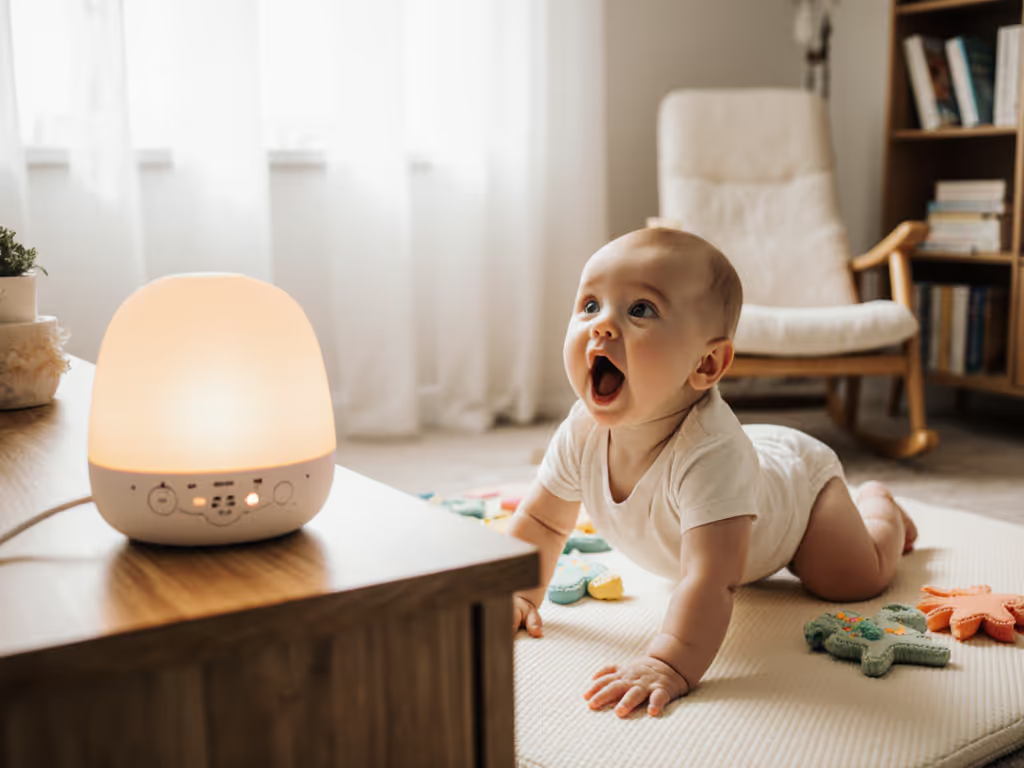
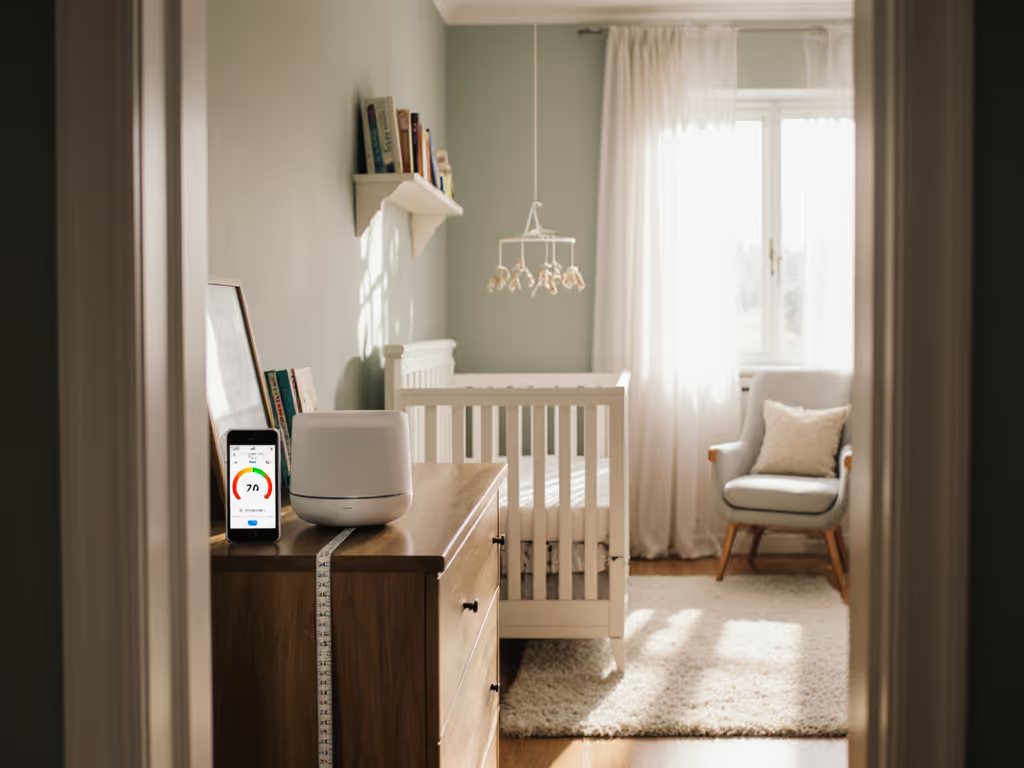
Newborn White Noise Machine Safety: Distance & Volume Rules
Focus on crib-distance measurements, not box specs: place the machine 7–8 feet from the crib and target 45–50 dBA with dBC no more than 5 dB higher while avoiding spectral peaks. Get clear steps for accurate phone-based testing and room-specific placement so masking works without overstimulating infants.
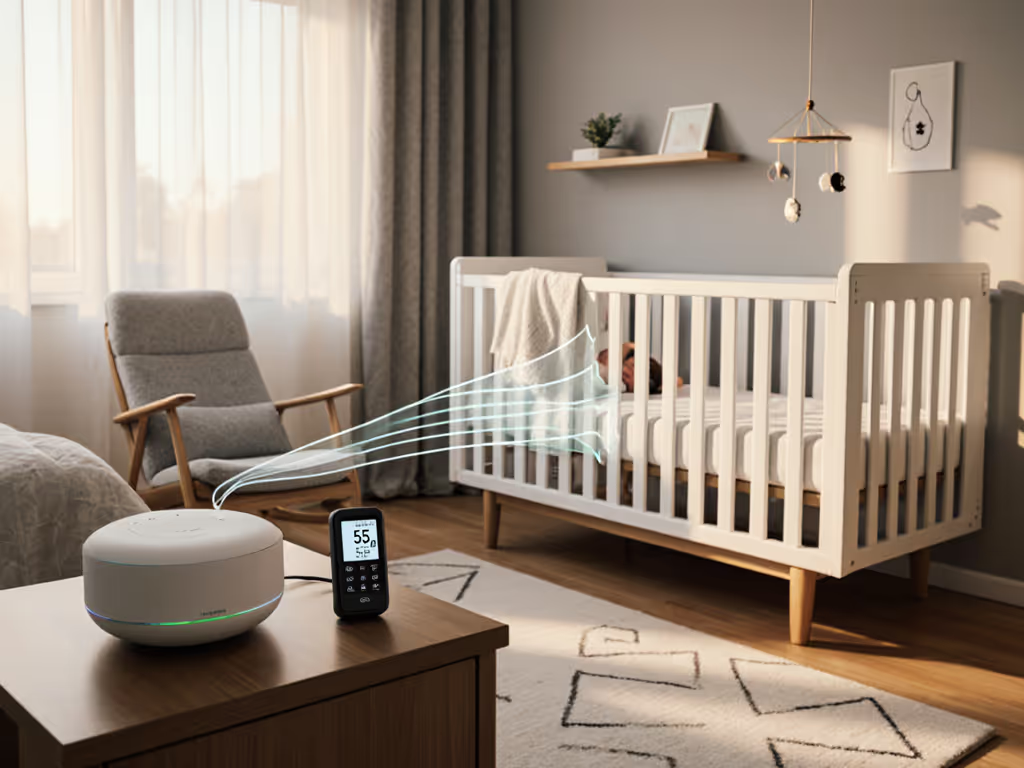
Baby White Noise Benefits: Safe 50-60 dB Decibel Guide
Use white noise safely and effectively by targeting 50–60 dBA at crib distance, choosing spectrally smooth sound, and placing the machine 6–8 feet away angled from the crib. Follow meter-based checks and avoid tonal peaks to mask noise without risking auditory strain or sleep disruption.
